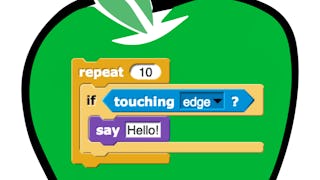How do we give instructions to a computer? Isn't programming hard? Not really! Whether it's giving someone directions to a nearby store or writing out some dance moves we frequently exhibit aspects of computational thinking in our everyday lives!


Computational Thinking for K-12 Educators: Sequences and Loops
This course is part of Computational Thinking & Block Programming in K-12 Education Specialization

Instructor: Beth Simon
3,065 already enrolled
Included with
(25 reviews)
Skills you'll gain
Details to know

Add to your LinkedIn profile
7 assignments
See how employees at top companies are mastering in-demand skills

Build your subject-matter expertise
- Learn new concepts from industry experts
- Gain a foundational understanding of a subject or tool
- Develop job-relevant skills with hands-on projects
- Earn a shareable career certificate

There are 6 modules in this course
Meet Dr. Simon and fellow learners in this class! Find out what you’ll be doing and learning.
What's included
2 videos2 readings1 discussion prompt
Is computational thinking everywhere? Reflect on computational thinking in your life and brainstorm instructions for real world tasks. Discuss the process by which we become better computing teachers and create a block-based program in Snap by reordering a set of provided instructions.
What's included
6 videos1 reading1 assignment1 discussion prompt
Get ready to do some programming puzzles! Create a Snap program and reflect on what aspects of the program students might struggle with. Work on challenge questions and reflect on how to discuss sequences in a classroom setting. Take a break from Snap and explore the code.org curriculums to create an assessment question!
What's included
11 videos7 readings2 assignments1 app item1 discussion prompt
Invent a faster way to write instructions for your robotic friend! Get started solving programming puzzles that use repeats and reflect on what areas students might struggle with. Reinforce your knowledge as you complete a set of programs on google slides -- this time without using Snap to check your work!
What's included
1 video4 readings2 assignments1 discussion prompt
More programming with repeats - except with a bit of a challenge! Explore the free curriculum on code.org’s platform analyzing the feedback and hints they provide for their activities. Work closely in their artist environment and examine the difference between code.org block-based programming and your work in Snap.
What's included
1 video2 readings1 assignment1 app item1 discussion prompt
Who is learning CS? How is CS being taught? Learn about the state of CS standards and teacher credentialing. Evaluate pedagogy techniques such as pair and buddy programing -- how effective are they in teaching CS?
What's included
4 videos2 readings1 assignment
Earn a career certificate
Add this credential to your LinkedIn profile, resume, or CV. Share it on social media and in your performance review.
Instructor

Offered by
Explore more from Education
 Status: Free Trial
Status: Free TrialUniversity of California San Diego
 Status: Preview
Status: PreviewUniversity of Michigan
 Status: Free Trial
Status: Free TrialDuke University
 Status: Free Trial
Status: Free TrialUniversity of California San Diego
Why people choose Coursera for their career




Learner reviews
25 reviews
- 5 stars
84%
- 4 stars
12%
- 3 stars
0%
- 2 stars
4%
- 1 star
0%
Showing 3 of 25
Reviewed on Oct 23, 2020
The videos and reading material are extremely student friendly. assignments are well paced.Enjoyed the experiencing and sharpening new skills and knowledge.Thank you

Open new doors with Coursera Plus
Unlimited access to 10,000+ world-class courses, hands-on projects, and job-ready certificate programs - all included in your subscription
Advance your career with an online degree
Earn a degree from world-class universities - 100% online
Join over 3,400 global companies that choose Coursera for Business
Upskill your employees to excel in the digital economy
Frequently asked questions
In this course you will learn to guide students in learning about sequences of instructions and basic counted repetition of instructions using Parsons' Problems to make learning less frustrating and give students more practice in less time.
You will also learn about common bugs students make in creating programs with sequences and repeats and specific approaches to help them figure out and fix their bugs. You will prepare to lead classroom discussions to deepen students knowledge and hear expert explanations you can model.
Finally you will learn about what is required to be authorized to teach computing in your state or country, explore the new Computer Science Teachers Association K-12 Computer Science Standards, be able to explain the benefits of block-based languages, and be prepared to support an equitable classroom using Pair Programming.
Yes! This course is designed as component of a Specialization that is 1 of a set of 4 Specializations (all will be offered on Coursera) that will support the requirements of the California Supplementary Authorization. Additionally, the Specialization may support credentialing or authorization in other states. However, most states require a transcript from an accredited institution of higher education. See the FAQ question on “Will I earn university credit” to find out how to get such a transcript.
Yes, you can earn UCSD credit for completing this course, but only by completing the full Computational Thinking and Block Programming in K-12 Education Specialization. In addition, you will need to (1) Enroll in an additional UCSD Extension course before completing the capstone ($500) and (2), complete part of the capstone project via an online proctoring service. After this is done, your Specialization course grades will be accumulated and a transcript with your final grade (both letter grade or pass-only supported) will be issued from UCSD with 4 graduate-level units. These are eligible to count towards the California Supplementary Authorization.
More questions
Financial aid available,

